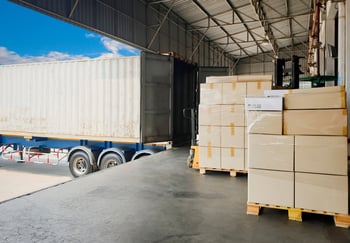
According to the National Retail Foundation, eCommerce is now the preferred method of shopping for 68% of consumers. Of course, the pandemic changed that as more and more people began shopping online out of necessity and then continued to do so out of convenience.
But the change in consumer preferences and behavior has had significant implications for eCommerce companies. Specifically, the drastic growth in online sales has introduced a host of unforeseen and fresh challenges for warehouses and fulfillment companies.
But, when there are challenges, there are usually also opportunities. Here are the main 2022 eCommerce fulfillment challenges and how eCommerce companies can face them moving forward.
What Are the 2022 eCommerce Fulfillment Challenges?
Not all eCommerce businesses are thriving in this new business environment. Many are struggling with these common eCommerce fulfillment challenges.
Challenge #1 — Managing Inventory Effectively
 It’s going to be tough to fulfill orders if you aren’t sure what products you have in stock. Consumers are increasingly frustrated when they place an order only to find out that the item is out of stock. Warehouses need efficient systems to manage inventory and avoid stockouts. Inventory management with archaic systems is likely to lead to errors and damage to your brand’s reputation.
It’s going to be tough to fulfill orders if you aren’t sure what products you have in stock. Consumers are increasingly frustrated when they place an order only to find out that the item is out of stock. Warehouses need efficient systems to manage inventory and avoid stockouts. Inventory management with archaic systems is likely to lead to errors and damage to your brand’s reputation.
Challenge #2 — Optimizing Warehouse Picking
One of the biggest order fulfillment challenges warehouses face is creating effective picking processes. Picking refers to the process of retrieving the right products from inventory after a customer places an order. It’s labor-intensive and can be rife with errors if not done correctly.
When picking isn’t efficient, it can result in order delays, damaged products, and the wrong items being sent to customers. This can be caused by:
-
- Too many manual processes or outdated processes
- Underutilization of personnel or equipment
- The lack of efficient automation and technology solutions
Challenge #3 — Using Complex Fulfillment Technology
What order fulfillment technology solutions do you use, if any? Many businesses have invested in some type of order fulfillment platform, but not all of them have chosen the right tools. For example, some solutions aren’t intuitive and make the assigned tasks harder rather than more efficient.
Other challenges are that the technology either doesn’t communicate or it isn’t mobile. When you invest in technology solutions for order fulfillment, it should have both of these features.
Challenge #4 — Slow Shipping Speeds
 Some of the largest eCommerce sellers have achieved success by making incredible promises about fast product shipping speeds - and delivering on those promises. This puts other online sellers in a tough position if they want to be competitive.
Some of the largest eCommerce sellers have achieved success by making incredible promises about fast product shipping speeds - and delivering on those promises. This puts other online sellers in a tough position if they want to be competitive.
Many consumers today expect fast shipping from the companies they do business with. But most aren’t unreasonable. You don’t have to get products to consumers the same day, or even tomorrow. But, you do need to ship fast and meet your promised deadlines.
If your shipping partners aren’t reliable or your internal processes are so disorganized that it takes days (or longer) to get products out the door, your business is going to suffer.
Challenge #5 — Inefficient eCommerce Returns
As more and more consumers shop for products online, more will also be returning items for a variety of reasons. Maybe they hit the wrong size button, didn’t read your description carefully or received a damaged product. Nearly one-third of all online purchases now risk being sent back to the warehouse, which has become a major logistical challenge.
Warehouses were initially set up to send products out to customers, not take them back. But reverse logistics, which is the process of handling returns, has become a vital part of eCommerce success. When you fail to give returns the attention they deserve, it will impact the customer experience and your overall business results.
Meeting eCommerce Fulfillment Challenges in 2022
Without effective order fulfillment strategies, your business is going to suffer. You run the risk of having stockouts, shipping the wrong or damaged items, and missing promised delivery deadlines. These risks can damage your relationships with customers, business partners, and even your own employees. Your profitability and business growth will be the final casualties. If you want to address the most common eCommerce fulfillment challenges, here are some strategies that you can implement.
Use an Inventory Management System
Inventory management is complex and one of the first things your eCommerce business needs to master. To automate some of these functions, consider upgrading to a warehouse management system (WMS) that includes features like inventory management, order fulfillment, real-time tracking, and returns management.
Shorten Shipping Distances
eCommerce companies can drastically shorten shipping distances and improve the customer experience by implementing a distributed fulfillment strategy. What does this mean? In certain markets, it makes sense to use smaller warehouses that are closer to customers instead of a single large warehouse. Businesses can also use different shipping providers to improve efficiency, such as working with last-mile courier services.
Use Technology to Simplify Picking
 Because order picking can be one of your eCommerce business’s most inefficient areas, it makes sense to dedicate resources to improving this part of your operation. Various tools can help automate picking and make it more efficient.
Because order picking can be one of your eCommerce business’s most inefficient areas, it makes sense to dedicate resources to improving this part of your operation. Various tools can help automate picking and make it more efficient.
Instead of having your warehouse workers walk back and forth inside the warehouse to get instructions and pull products, consider using mobile powered carts that move the technology to the warehouse floor. You can also connect automation tools like wireless headsets to this technology so that your pickers receive instructions via voice and can work hands-free.
Improve Your Reverse Logistics Processes
If you implement the other solutions just listed, you already have everything you need in place to improve your reverse logistics processes. When a customer wants to return a product, you can use your WMS to process that return automatically and provide tracking. Your mobile powered carts and wireless solutions can also be used to process returns as they come back into the warehouse, providing a better overall process and customer experience.
With consistent online sales growth, businesses need to face their current eCommerce fulfillment challenges. The challenges and solutions listed above are an excellent starting point. Specifically, leveraging technology solutions can help improve efficiency, reduce costs, and deliver a better customer experience.












